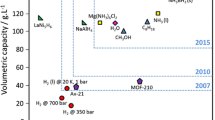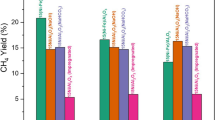Abstract
The oxidation reactions of dichloromethane, dichloroethane and n-hexane were carried out over honey-comb type platinum basic VOC catalyst (BVC) containing vanadium, chromium, manganese, cobalt, copper or barium. In dichloromethane and dichloroethane catalytic oxidation up to 450 °C, chromium was found as the most active component. Although vanadium was also effective initially, it was deactivated after treatment in the furnace at 800 °C for 120 hours. Chromium, cobalt, vanadium and barium promoted catalysts showed higher activities than BVC in the reaction of n-hexane.
Similar content being viewed by others
References
Bertelsen, B. I., “Catalytic Control of VOC Emissions”, MECA (Manufacturers of Emission Controls Association), USA (1992).
Betty, J. M., “Technology Design for Destruction and Removal of Chlorinated Chemicals”,Ind. Eng. Chem. Res.,36, 513 (1997).
Cordi, E. M. and Falconer, J. L., “Oxidation of Volatile Organic Compounds on A12O3, Pd/Al2O3, and PdO/Al2O3 Catalysts,”J. Catal.,162, 104 (1996).
Drago, R. S., Petrosius, S. C., Grunewald, G. C. and Brendley, W. H., “Deep Oxidation of Chlorinated Hydrocarbons”,Environ. Catal. A. Chem. Soc.,28, 340 (1994).
Freed, I. M., Frost, A.C., Herbert, K.J., Meyer, F.J. and Summers, J. C., “New Catalyst Technologies for the Destruction of Halogenated Hydrocarbons and Volatile Organics”,Catal. Today,17, 367 (1993).
Greene, H., Prakash, D., Athota, K., Atwood, G. and Vogel, C., “Energy Efficient Duel-Function Sorben/Catalytic Media for Chlorinated VOC Destruction”,Catal. Today,27, 289 (1996).
Heck, R. M. and Farrauto, R.J., “Catalytic Air Pollution Control: Commercial Technology”, ITP,9, 147 (1995).
Jones, J. and Ross, J. R. H., “The Development of Supported Vanadia Catalysts for the Combined Catalytic Removal of the Oxides of Nitrogen and of Chlorinated Hydrocarbons from Flue Gases”,Catal Today,35, 97 (1997).
Mazzarino, I. and Barresi, A. A., “Catalytic Combustion of VOC Mixtures in a Monolithic Reactor”,Catal. Today,17, 335 (1993).
Nguyen, P., Stern, E. W., Amundsen, A. R. and Balko, E., “Oxidative Destruction of Chlorocarbons”, ICAC Forum, USA (1993).
Noordally, E., Richmond, J. R. and Tahir, S. F., “Destruction of Volatile Organic Compounds by Catalytic Oxidation “,Catal. Today,17, 367 (1993).
Vigneron, S., Deprell, P. and Hermia, J., “Comparison of Precious Metals and Base Metal Oxides for the Catalytic Deep Oxidation of VOCs from Coating Plants”,Catal. Today,27, 229 (1996).
Author information
Authors and Affiliations
Rights and permissions
About this article
Cite this article
Jang, BH., Lee, SS., Yeon, TH. et al. Effects of base metal promoters in VOC catalysts for chlorocarbons and n-Hexane Oxidation. Korean J. Chem. Eng. 15, 516–521 (1998). https://doi.org/10.1007/BF02707102
Received:
Accepted:
Issue Date:
DOI: https://doi.org/10.1007/BF02707102




